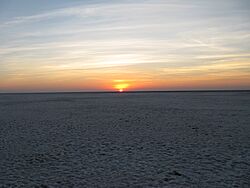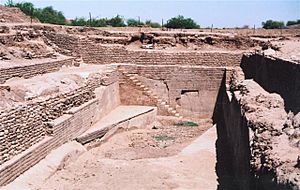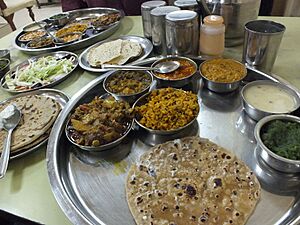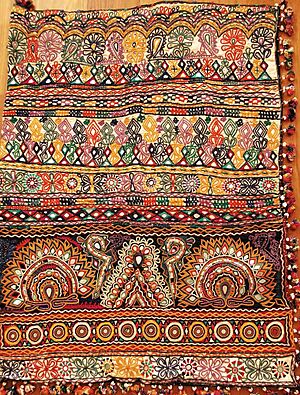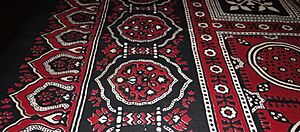Kutch district facts for kids
Quick facts for kids
Kutch
|
|
|---|---|
|
District of Gujarat
|
|
| Kachchh | |
|
Clockwise from top-left: Prag Mahal, Sun Temple in Kotai, Mundra Port, Rann of Kutch, Dholavira
|
|
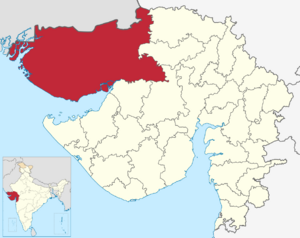
Location of Kutch district in Gujarat
|
|
| Country | |
| State | Gujarat |
| Headquarters | Bhuj |
| Tehsils | 10 |
| Area | |
| • Total | 45,674 km2 (17,635 sq mi) |
| Population
(2011)
|
|
| • Total | 2,092,371 |
| • Density | 45.8110/km2 (118.6499/sq mi) |
| Demographics | |
| • Literacy | 70.59 |
| • Sex ratio | 908 |
| • Language | |
| Time zone | UTC+05:30 (Indian Standard Time) |
| Vehicle registration | GJ-12 |
| Major highways | 1 |
| Official name: Dholavira: A Harappan City | |
| Type: | Cultural |
| Criteria: | Cultural: (iii)(iv) |
| Designated: | 2021 (44th session) |
| Reference #: | 1645 |
| Region: | Southern Asia |
Kutch district, also spelled Kachchh, is a large area in the western Indian state of Gujarat. Its main city and capital is Bhuj. Kutch is huge, covering about 45,674 square kilometers. This makes it the largest district in all of India! It's even bigger than some entire countries, like Estonia.
The word "Kutch" means something that gets wet and then dries up. A big part of the district is called the Rann of Kutch. This is a shallow wetland that fills with water during the rainy season. Then, it dries up in other seasons, leaving behind a white, salty flat land. It looks like snow! The word "Kutch" also means "tortoise" in Sanskrit.
Kutch is surrounded by water on its south and west sides, with the Gulf of Kutch and the Arabian Sea. To the north and east, it has the Great and Little Rann, which are seasonal wetlands. Kutch is also very close to the border with Pakistan.
About 2 million people live in Kutch. Around 30% of them live in cities. The people of Kutch are called Kutchi people and they speak the Kutchi language. The district has good connections by road, train, and air. It even has four airports!
Contents
Kutch: A Look at Its Past
The history of Kutch goes back a very long time, even to prehistoric times. People have found sites from the ancient Indus valley civilization here. Kutch is also mentioned in old Hindu mythology stories.
Later, Greek writers talked about Kutch during the time of Alexander the Great. Over many centuries, different groups ruled Kutch. These included the Maurya Empire, the Gupta Empire, and local dynasties like the Maitraka dynasty.
By the 13th century, the Vaghelas took control of Kutch. They then became known as the Jadeja rulers. For about 300 years, Kutch was split and ruled by different branches of the Jadeja family.
In the 16th century, Rao Khengarji I brought Kutch back together under one rule. His family ruled for two centuries. They had good relationships with the Gujarat Sultanate and the Mughals.
In 1819, Kutch became part of the British East India Company's control after a battle. That same year, a big earthquake hit the state. Despite this, Kutch became stable and grew in business under later rulers.
When India became independent in 1947, Kutch joined the country. It became a separate state in 1950. Another earthquake happened in 1956. In 1960, Kutch became a district of the new state of Gujarat.
Kutch faced more challenges with a tropical cyclone in 1998 and another major earthquake in 2001. But after these events, Kutch saw fast growth in industries and tourism.
Rivers and Water in Kutch
Kutch has many small rivers, about 97 of them! Most of these rivers flow into the Arabian Sea. Some others flow into the Rann of Kutch.
There are also many dams in the district. These dams collect rainwater during the monsoon season. While the dams help store water, they also mean less fresh water flows into the Ranns of Kutch naturally.
Water supply is a big deal in Kutch. The district now gets a lot of its water from the Narmada River, which flows from the Sardar Sarovar dam.
Wildlife and Nature Reserves
Kutch is a great place for nature lovers! It has many important areas for wildlife conservation. You can visit places like the Indian Wild Ass Sanctuary, which protects the unique wild ass.
Other amazing places include the Kutch Desert Wildlife Sanctuary, Narayan Sarovar Sanctuary, and Kutch Bustard Sanctuary. The Banni Grasslands Reserve and Chari-Dhand Wetland Conservation Reserve are also important for different animals and plants.
Culture of Kutch
People and Communities
Kutch is home to many different groups of people and communities. You can find nomadic groups, semi-nomadic groups, and skilled artisans living here. The Rabari people are a large group in Kutch. The Ahir community is also known for being brave and noble.
Food and Drink
Most people in Kutch are Hindu or Jain, so the food is mostly vegetarian. Jain people also avoid eating root vegetables like potatoes and onions. There are also many Muslims in Kutch who eat vegetables, chicken, and mutton.
In the villages, common foods include kadi-khichdi (a rice and lentil dish), milk, and bajra (pearl millet). Bajara na rotla (millet bread) with curd and buttermilk is a favorite.
Milk is very important in Kutch. Offering milk is a sign of friendship and welcome. In engagement ceremonies, the bride's family offers milk to the groom's family to show they accept the relationship. People also drink a lot of buttermilk with lunch. Tea is the most popular drink.
Kutch's Economy
Kutch was once seen as a less developed area because of its location. The big earthquake in 2001 made things even harder. But in the years after, Kutch's economy grew incredibly fast! This was thanks to strong efforts by the Gujarat government.
Today, Kutch is a growing center for business and industry. It's located on India's far western edge. This has led to two major ports being built: Kandla and Mundra. These ports are the closest to the Gulf of Arabia, which means they are important for trade with Europe by sea.
The roads in Kutch are also very good. Much of this improvement happened after the 2001 earthquake as part of the recovery efforts.
Trade and Ports
Because of the two major ports, Kandla and Mundra, transportation and trade are big businesses here. Historically, people from Kutch were key to trade between Gujarat and Sindh. After Pakistan was formed, this trade stopped. But with the Kandla port, trade boomed again. Kandla port is seen as a "Gateway to North India."
Minerals and Resources
Kutch has many valuable minerals. It has large amounts of Lignite (a type of coal), Bauxite, and Gypsum. After the 2001 earthquake, industries in Kutch received tax breaks for 15 years, which helped them grow.
Lignite is mined by the Gujarat Mineral Development Corporation (GMDC) at two mines.
Cement and Power
Kutch also has large cement factories. Companies like Gujarat Anjan Cement Limited and Sanghi Industries Ltd have plants here. They are planning to make even more cement in the future.
Timber Industry
Kutch does not have many forests, so there's little risk of illegal logging. But the good facilities at Kandla port have helped create a big timber market. The timber industry is growing fast, with many sawmills in the Gandhidham-Kandla area.
Salt Production
The Little Rann of Kutch is famous for its traditional salt production. People have been making salt here for about 600 years! During the British rule, salt production grew a lot. It even helped pay for a big part of the British government's military costs.
Communities like the Chunvaliya Koli, Ahir, and Miyana (Muslim) are known as 'Agariyas'. They live in villages around the Lesser Rann of Kutch and have the traditional skills for making salt. Since the water in these villages is salty, farming is not possible. So, making salt is their main way to earn a living.
Gujarat produces about 75% of India's total salt, and much of this comes from Kutch.
Textile Art
Kutch is one of the best places in India for textile art. Kutch Embroidery is very detailed and colorful. A special type of embroidery includes small mirrors sewn into the fabric, which is a unique art form of this region.
Different tribes and groups in Kutch have their own unique styles of embroidery. For example, the Rabaris, a nomadic tribe, have their own evolving craft traditions. The Rohanas tribals are known for their skirt work, and the Sodhas use geometric patterns.
Kutchi embroidery often involves weaving a net on cloth with thread. Then, the net is filled in using the same thread with complex stitches. The patterns are usually based on geometric shapes.
Important Religious Places
Kutch has many important religious sites for different faiths.
- Narayan Sarovar Temple and Koteshwar Temple are significant Hindu temples.
- The Ashapura Mata temple at Mata no Madh is very important. Ashapura Mata is the family goddess of the former Jadeja rulers of Kutch.
- The Swaminarayan Sampraday has many followers in Kutch. Their main temple is Shri Swaminarayan Mandir, Bhuj.
- For Muslims, the main shrine is Shah Zakariya Ali Akbar, Hajipir.
- Lakhpat is a special place because it has religious meaning for Hindus, Sikhs, and Muslims.
- The temple of Gudthar Vara Shri Matiya Dev is important for the Maheshwari sect.
Kutch also has many important Jain pilgrimage sites:
- Shri Bhadreshwar Jain Tirth Derasar
- Koday Jain tirth (famous for its 72 Jinalaya Jain Temple)
- Vanki Mahavir Jain Temple
- Kothara Shantinath Jain Tirth
- Naliya Thirth Jain Derasar
- Jakhau Mahavirswami Sw. Jain Tirth
- Suthri Dhrutkallol Parshwanath Maha Tirth
Images for kids
-
Dholavira, one of the largest cities of the Indus Valley Civilisation, with stepwell steps to reach the water level in artificially constructed reservoirs.
-
Ten Indus characters from the northern gate of Dholavira, dubbed the Dholavira Signboard.
See also
 In Spanish: Distrito de Kutch para niños
In Spanish: Distrito de Kutch para niños






